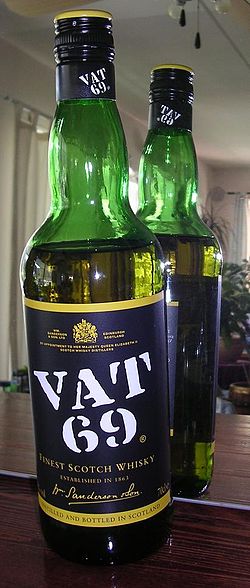Vat 69 whisky

A partial bottle of Vat 69 whisky.
|
|
| Type | Scotch blended whisky |
|---|---|
| Manufacturer | William Sanderson & Son Limited |
| Distributor | Diageo |
| Country of origin | Scotland |
| Introduced | 1882 |
Vat 69 is a Scotch blended whisky created by William Sanderson & Son Limited of South Queensferry, Scotland, now part of Diageo.
William Sanderson was born in Leith, Scotland January 27, 1839. He started an apprenticeship with wine and spirituous liquors producer Matthew Buchan at the age of 13. By 1863, he already owned his own business producing liqueurs and whisky blends. In 1880, his son William Mark joined the business and persuaded his father to bottle various blends of whisky.
The iconic Vat 69 bottle with its bulbous neck was introduced to the market and was not changed for the next hundred years. In 1882, William Sanderson prepared one hundred casks of blended whisky and hired a panel of experts to taste them. The batch from the cask (or “vat”) with number 69 was judged to be the best, and this provided the whisky's brand name. The whisky was at first bottled in port bottles. In 1884, Sanderson bought the Glen Garioch distillery which was situated in the middle of a barley field. The distillery was meant to ensure the delivery of grain whisky.
Sanderson took care that there were always new products to be blended, because DCL, which was a strong society at that time, controlled such a large amount of the production that it had a huge influence on the supply of the competing company. For this reason Sanderson, together with Usher and Bell, founded a company to produce grain whisky, which still exists today as the North British Distillery. Sanderson sourced a few malt whiskies used to blend VAT 69 from a friend, John Begg, who owned the Royal Lochnagar distillery. When Begg died, Sanderson became director of Begg's distillery. In 1933, Sanderson's company merged with Booth's Distilleries, which merged again with the DCL-Group in 1935.
...
Wikipedia
